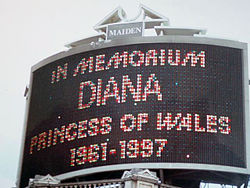| Revision as of 14:49, 21 August 2007 editRadiant! (talk | contribs)36,918 editsm Reverted edits by Crum375 (talk) to last version by Radiant!← Previous edit | Revision as of 14:50, 21 August 2007 edit undoRadiant! (talk | contribs)36,918 editsm moved Anna Svidersky to Mourning sickness over redirect: You suggested that any admin can revert you if you're incorrect. You ARE incorrect, as well as going against consensus. Hence, revertedNext edit → |
| (No difference) | |
Revision as of 14:50, 21 August 2007
| The neutrality of this article is disputed. Relevant discussion may be found on the talk page. Please do not remove this message until conditions to do so are met. (Learn how and when to remove this message) |
| It has been suggested that this article be merged with Mourning. (Discuss) Proposed since August 2007. |
Mourning sickness is a collective emotional condition of "recreational grieving" by individuals at the passing of celebrities or victims of murder.
History

The history of mourning sickness in Great Britain can be traced to the public reaction to the Dunblane massacre that occurred in Scotland in 1996 when a lone assailant killed sixteen schoolchildren and one adult at the Dunblane Primary School. The tragedy prompted a public reaction that brought a flood of flowers and sympathy cards from across Great Britain. A worldwide exhibit of mourning sickness followed the death of Diana, Princess of Wales in 1997 when the Princess was killed in a car crash in Paris. Almost immediately following word of her death, makeshift memorials to Diana began to pop up, most notably at her residence at Kensington Palace. The memorials became a gathering place for public weeping and for people to bring flowers. Similar displays of public grief occurred following the death of Linda McCartney and the murders of BBC journalist Jill Dando, an 8 yr West Sussex girl Sarah Payne and two Cambridgeshire schoolgirls from Soham.
Anna Svidersky

The advent of the internet added a new development in public mourning sickness that was displayed following the murder of American teenager Anna Svidersky in Vancouver, Washington. Anna was murdered while working at a McDonald's restaurant, by schizophrenic sex offender David Barton Sullivan. News of her death quickly spread worldwide, initially through the Internet friends site MySpace, where she had a personal page, and then through other similar sites. This created an effect of mass grief and mourning for her around the world mostly from people who had previously known nothing about her.
In Britain The Guardian newspaper compared the widespread expression of grief by strangers to that seen after the death of Princess Diana. The paper cited the 2004 Civitas think-tank, which described such grief as "mourning sickness", related to people's own emotional needs, rather than any real rapport with the deceased.
Criticism
Some critics have described the public displays of mourning as "phony" and more for the benefit of the people grieving than for the victims, families or individuals that they are grieving for. The media plays a pivotal role in these displays, focusing attention on the public reaction to these events. Other said that "grief tourists" use the tears shed over strangers and celebrities as a form of self-indulgent catharsis, that the grief explosions are an exercise in narcissism, and that manufactured grief, complete with flowers and teddy bears, is the new opiate of the masses.
References
- ^ S. O'Neil "Britain 'wallowing in mourning sickness' Telegraph Feb 23rd, 2004
- Adams, Kelly (June 27, 2007). "Sullivan acquitted due to insanity". The Columbian. Retrieved 2007-07-12.
{{cite news}}: Unknown parameter|coauthors=ignored (|author=suggested) (help) - ^ Jonze, Tim (May 15, 2006). "Death on MySpace". The Guardian. Retrieved 2006-05-23.
- "Mourning sickness is a religion" Feb 23rd. 2004
- F. Furedi "Mourning Sickness" The Independent August 25th, 2002
- Halley, Gwen, "Grief tourists lap up other people's pain." The Independent, Ireland, March 14, 2004. Retrieved August 15, 2007

